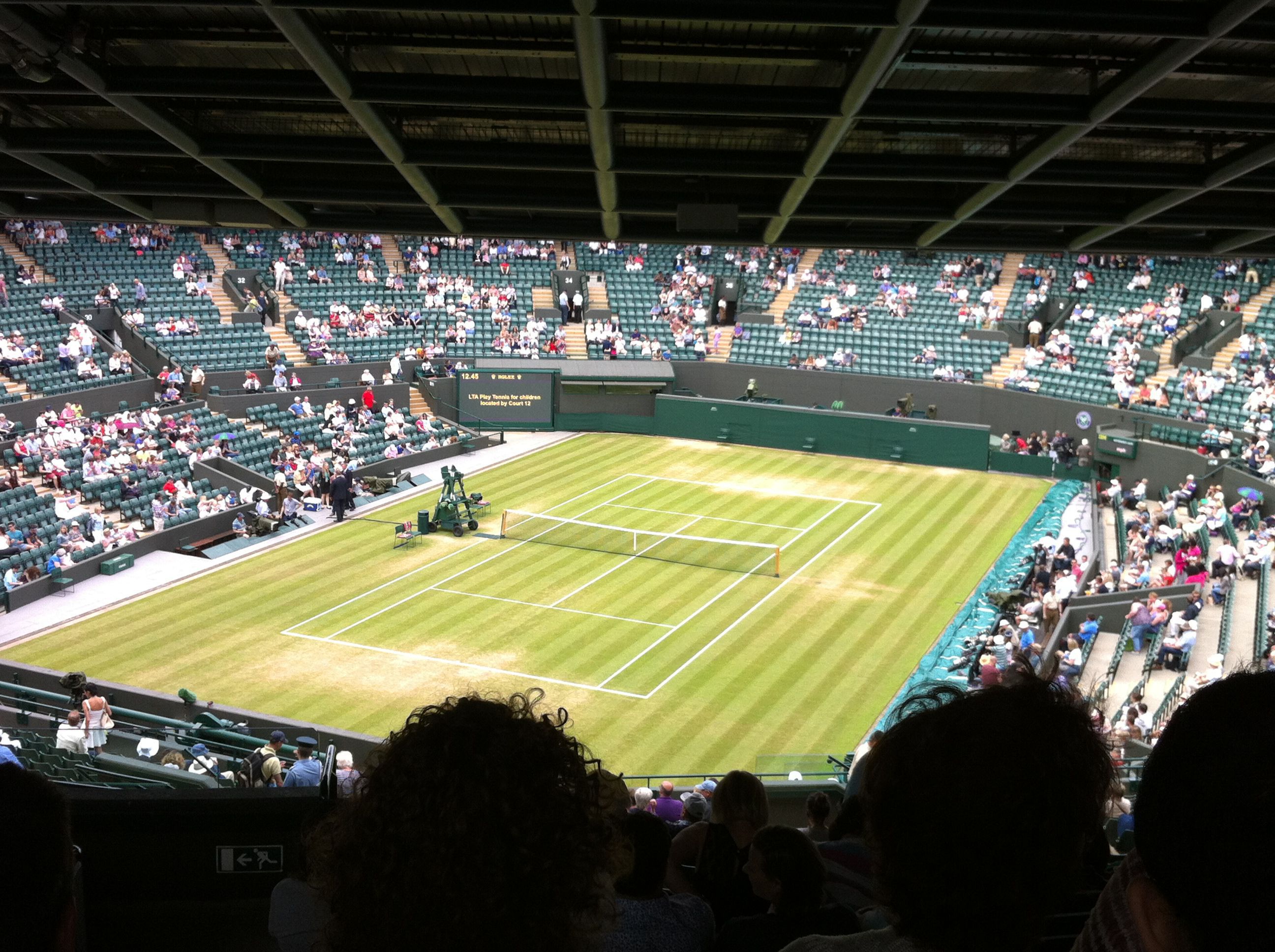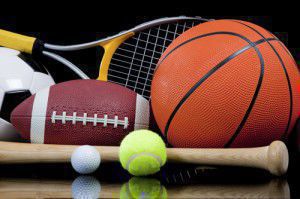The weird and wonderful language of tennis
I’m not generally much of a sports fan, and the less said about my sporting ability – or lack thereof – the better… but I do love a good tennis match. I’m a regular supporter of the British Davis Cup team (which is a lot more fun since they started winning; our humiliating weekend in Lithuania back in 2010 is, thankfully, a distant memory). I’m going to the US Open for the first time this autumn (squeal), and don’t even try booking me for any social engagements during Wimbledon fortnight – if anyone needs me then, I’ll be in front of the TV drinking Pimm’s, eating strawberries and cream and biting my nails every time Andy Murray’s on court.

Wimbledon, summer 2013
Like any sport, tennis has its own unique language and growing up watching it on TV, I had to get fluent at an early age. Besides a frankly baffling scoring system (15, 30, 40, advantage… it makes no sense at all) the game features a good few terms that may not mean a lot to newcomers, and take a while to get used to. So as the French Open comes to a close and we look ahead to the grass court season, here’s a quick guide to Tennis-ese for the uninitiated:
Love: ironically this is not something you want in a tennis match, because ‘love’ means a score of zero points in a game (or games in a set). It’s generally assumed that this comes from the French word l’oeuf, which means ‘egg’ – the same shape as a zero.
Deuce: when the score reaches 40-40 in tennis (3 points each), one player must score two consecutive points in order to seal the game. If they only manage one, the score returns to deuce, and keeps doing so until someone wins the game. ‘Deuce’ could derive from deus, Old French for two, or from à deux de jeu (‘two points from the end of the game’)… and yet, ironically, in France 40-40 is referred to as quarante à the first time, then egalité after that.
Let: when a player serves, the ball must pass over the net and bounce in the service box diagonally opposite. If it goes into the net, or misses the service box, this is a fault; do two faults in a row and you forfeit the point. But if the ball touches the net and still lands in the correct service box, this is called ‘let’. Nobody seems quite sure why, although one possibility is that it’s a shortened version of the French word for ‘net’, filet. Or it could just be because if this happens when you serve, the umpire lets you try again as many times as you need to 😉
Bagel: depending which side of the net you’re on, this is either something to celebrate or a very, very Bad Thing. A bagel occurs when one player wins a set 6-0. If this happens twice in a match it’s a double bagel. I’ve also heard a set that’s been won 6-1 referred to as a breadstick. Who knew so many tennis terms were named for the shape of food?
And finally, a couple of tennis terms with less interesting linguistic origins:
Break and Hold: the players in a tennis match take it in turns to serve. If a player wins a game on their own serve, this is called ‘holding serve’ or just ‘a hold’. On the other hand, if they manage to win a game when their opponent’s serving, this is called a ‘break’, or ‘breaking their serve’. To win a set, a player must be ahead by at least two games, so a break often proves crucial. During a tiebreak, you can also get a ‘mini-break’, which is not, as one might suppose, a short holiday but just means you’ve won a point on your opponent’s serve.
Ace: a serve that goes in but is untouched by the opponent’s racquet, automatically winning the point for the server. John Isner currently holds the record for the most aces in a match, at 115, but then again, that was also the longest singles match ever played – 11 hours, 5 minutes – at Wimbledon 2010, so perhaps it’s not so surprising.
These are just a few examples of the weird and wonderful language of tennis. What’s your favourite tennis term? And – far more importantly – who will you be cheering for at Wimbledon this year?
Liz
Goal! around the world [Infographic]
Sometimes one word is all you need… With the World Cup getting underway today, here’s how each national team says that all-important word, ‘goal’.
You can find this and lots more in our language learning app, uTalk – available to download and start learning right now from the App Store. So whether you’re watching the football at home or away, you’ll always be prepared.
(There are lots of non-football related words in there too, for those of us with other interests!)
Please do share the infographic with friends and tell us how you’ll be shouting ‘Goal!’ this World Cup 🙂
Embed This Image On Your Site (copy code below):
10 sport stars who speak other languages
 It can often feel like life is all about sport, whether we like it or not. But have you ever wondered how good sports stars are at languages?
It can often feel like life is all about sport, whether we like it or not. But have you ever wondered how good sports stars are at languages?
It turns out, pretty good. Like anyone who has to travel a lot for their work, athletes often find knowing only their native language isn’t enough. Here are 10 great examples of sports stars who speak more than one language.
Gary Lineker
Besides English, the former footballer learnt Spanish while he was playing for Barcelona, and picked up some Japanese when he later moved to Nagoya Grampus Eight. He’s now a passionate ambassador for languages in schools, saying in an interview with TES last year, ‘the learning of languages, for me, will always be helpful for the vast majority at some stage in their life’.
Roger Federer
Not content with winning a frankly quite ridiculous 17 Grand Slam titles, the Swiss tennis player also speaks four languages fluently – his native Swiss German along with French, English and German. He’s known for his ability to switch effortlessly between languages in interviews and press conferences and can quite comfortably answer journalists’ questions in their own language, a feat some of his fellow tennis players can’t keep up with. Wouldn’t be the first time.
Tom Daley
The British diver recently got an A in his Spanish A-level (congrats, Tom!), and makes good use of his language skills when in Mexico, where he spends a lot of his time. Here’s a video of him showing off his Spanish.
Jonny Wilkinson
Here in England, Jonny Wilkinson is known (at least by me) as that guy who’s pretty good at drop goals. But he’s also a bit of a superstar in France, where he’s been playing for Toulon since 2009. He’s now fluent in French and was awarded honorary citizenship of Toulon earlier this week – giving his acceptance speech in the local language, of course.
Fernando Alonso
The Spanish Formula One racing driver speaks an impressive four languages – Spanish, Italian, English and French. And in case that’s not enough, he’s apparently working on Russian too.
Arsene Wenger
The Arsenal manager is well known for his interest in languages, speaking French, English, German, Spanish, Italian and Japanese. Like Gary Lineker, Wenger’s also known as an ambassador for languages, and last year he was voted Britain’s first Public Language Champion by readers of The Guardian. In this video he explains why languages are so important.
Novak Djokovic
Never one to let Roger take all the glory, fellow tennis champion Novak Djokovic speaks five languages – Serbian, English, German, Italian and French. He studied English and German at primary school, and learned Italian when he worked with coach Riccardo Piati. In an interview with Tennis Talk in 2013, he said, ‘We have a saying in our country: The more languages you know, the more is your worth as a person. I like to understand what people are saying wherever I am, at least to pick up a few phrases of those languages.’
Paula Radcliffe
Long-distance runner Paula Radcliffe has a first-class degree from Loughborough University in European Studies, and speaks French and German fluently. She now lives in Monaco with her husband and two children, who are both bilingual, attending a French school but also fluent in English.
Cesc Fabregas
Another Barcelona footballer, Fabregas speaks four languages – Spanish, Catalan, English and French, and his Twitter feed is multilingual. When asked about his language skills in 2005, he replied, ‘These days you have to keep studying, not least because my mum tells me so.’ Words to live by.
Daniela Hantuchova
And finally, another tennis player, because tennis is my favourite. Daniela Hantuchova, from Slovakia, is by all accounts a very talented lady. Besides her tennis career, she’s also a trained classical pianist, and speaks – wait for it – six languages: Slovak, Czech, English and German fluently, and some Croatian and Italian.
Does anyone else feel like a bit of an underachiever now, or is it just me?
If you know any other examples of sports stars who speak other languages, please tell us about them in the comments.
10 Reasons to Visit… Pittsburgh
We love sharing our reasons to visit different places around the world, but we also enjoy hearing from you. Is there somewhere we’ve missed that you want everyone to know about?
Today we’re hearing from Emily Nemchick, who lives in Pittsburgh, Pennsylvania, with her top ten reasons to visit the city.
1. The Museums
Although many Londoners might baulk at having to pay to enter Pittsburgh’s museums, they are well worth a visit if you’re in town. Pittsburgh’s Carnegie museums offer a whole day’s worth of fun for art or history lovers. The Andy Warhol museum is also worth looking up for pop art fans, and the Mattress Factory is the perfect day trip for enthusiasts of quirky and imaginative art installations.
2. Mt. Washington
Mt. Washington offers some of the best views of Pittsburgh’s downtown, rivers and gorgeous skyline. Though it has a reputation as a rust-belt city, Pittsburgh’s setting at the confluence of the Ohio and Monongahela rivers makes for some extremely worthwhile vantage points from Mt. Washington’s overlook. Plus, if the season is right, Mt. Washington has some pretty darned good ice cream, too.
3. The Three Rivers Heritage Trail
Anyone who likes to bike or hike should definitely give Pittsburgh a go. Not only does it have trails aplenty, it boasts a biking trail that stretches from downtown Pittsburgh all the way to Washington D.C. For less adventurous bikers or those questing for a quiet stroll, there are also shorter riverside trails, which are a great way to see Pittsburgh whilst enjoying a bit of nature.
4. Local Cuisine (Pierogies!)
Pittsburgh has strong Polish heritage, and as such a local favourite is pierogies. If that isn’t your thing, there are still countless local restaurants offering a range of tasty cuisines. There are great places scattered all over town. Try Primanti Bros for a real taste of traditional Pittsburgh fare – their specialty is sandwiches with chips (French fries) and coleslaw inside the sandwich. It’s pretty decent, actually.
5. Pirates, Penguins and Steel
Not too many actual pirates or penguins unfortunately, but Pittsburgh’s sports teams might make up for the lack if you’re into American football, baseball or ice hockey at all. Pittsburgh’s PNC Park is a huge sports stadium which is a great place to catch a game if you’re in the Burgh during baseball season.
6. The Strip District
This is my absolute favourite place to be in Pittsburgh. The Strip District isn’t as naughty as it sounds, but it’s a great place to spend the afternoon nonetheless. The Strip is a long street boasting specialty cheese stores, coffee shops, fishmongers, butchers, baked goods, spices, open fruit and veg markets and a ton of great bars and restaurants. Anything you want to buy, you can buy in the Strip. It’s also a great place just to window shop and hang out.

7. Phipps Conservatory
Pittsburgh not only has awesome museums but a pretty nifty conservatory chock full of gorgeous flowers and plants. The exhibits change with the seasons, but they are always worth a visit.
8. The South Side
Anyone in search of some nightlife should check out the South Side, home to the happiest happy hours, the hippest clubs (I would assume from their long lines on Saturday nights) and the hoppiest bar hops (I wanted to keep that going there, but seriously, good bars). The South Side is a great place to go out to dinner, grab a few drinks or have a night out on the town affordably.
9. Station Square
Station Square is a fun place to check out some nice boutiques or head to a fancy restaurant. In the summer, it’s also the ideal place to break up a bike ride with a rest and a drink, because it’s right on the South Side bike trail. You can even roll your sightseeing into one and hop on the Incline (cable car) down from Mt. Washington. Pittsburgh is pretty pocket-sized, so it’s a great place to explore on foot, and Station Square is a fun and convenient addition to any itinerary.
10. Breweries
I confess, I saved the best until last. Pittsburgh is the home of many fantastic breweries, and locally brewed beer is pretty epic. Church Brew Works is a must-see as a brewery built inside a converted church, East End Brewing Co. has some tasty seasonal brews, and even whiskey fans can enjoy Pittsburgh’s locally distilled whiskey at Wigle.
It may not be the most glamorous city, but Pittsburgh has tried hard to change its traditional image as a rust-belt city and is regarded as one of America’s most livable cities. It’s guaranteed to keep tourists happy for days too. Stop by if you get a chance!
By Emily Nemchick, English expat and happy Pittsburgh resident.
Website: http://emilynemchick.weebly.com/
Blog: http://londontopittsburgh.wordpress.com/
Do get in touch with us if you’d like to share a ’10 reasons’ post of your own, or you have a suggestion for where we should cover next.
The EuroTalk Guide to the Winter Games 2014 [Infographic]
If you follow us on Facebook or Twitter, you’ll be aware that over the last couple of weeks, we’ve been enjoying the Winter Olympics, and we’ve been sharing our guide to the different events. Some of them were quite new to us and we had fun discovering what they were all about. So if you’ve been mystified by any of the sports, we hope this complete guide will help.

Embed This Image On Your Site (copy code below):



